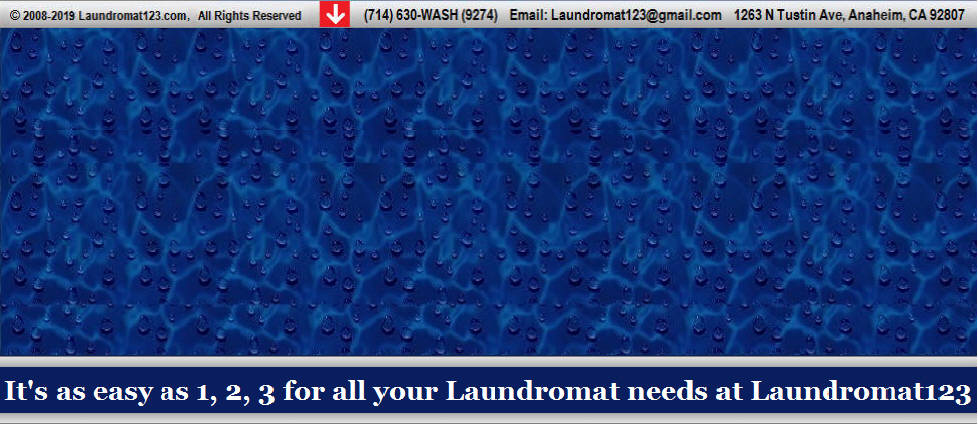Q. WHY SHOULD I INVEST IN THE LAUNDROMAT BUSINESS?
The Laundromat business is a sound investment opportunity. It's an all-cash, low labor and recession-resistant business. With one attendant, you can run a professional laundry service. Laundromats have been a growth business in the past and should continue to be so in the future. CBS Evening News, the N.Y. Times and The Wall Street Journal have saluted Laundromats as an exciting and growing business. Now with over 65% of American women of working age employed, less time is available for traditional household chores and more families are turning to the Laundromat alternative as a way to save time and achieve professional washing results.
Q. CAN YOU SAY IN ONE SENTENCE WHY A LAUNDROMAT IS A GOOD INVESTMENT?
Yes. Because it is an all cash business with the potential for successful operation on an absentee basis with fast cash down-payment return requiring minimum amounts of your unscheduled time but still provides excellent depreciation tax benefits, has a potential to build increased volume, needs no direct customer contact or prior knowledge of the business, little or no labor costs, no monthly franchise fees, no accounts receivables to collect, no inventory to manage, no bad checks, no skilled staff required, no professional license required, no competition from mass merchandisers, minimal administrative needs and it can make you a lot of money.
Q. WHO SHOULD BUY A LAUNDROMAT?
People from all walks of life and ethnic origins are investing in Laundromats. It is a common sense business, requiring minimal supervision. It can be run on an absentee basis, which helps you avoid giving up your current profession or other source of income. Unlike many small businesses, the self-service nature of Laundromats allows owners a great amount of freedom and flexibility. Operators don't spend their working day behind a counter or in the stockroom. In fact, their full-time presence is seldom required at the business site. The lure of absentee ownership has generated many types of entrepreneurs. Some are semi-retired individuals setting their own pace, enjoying their one-store ownership. Others are multiple-store owners, whose daily itinerary takes them to their various locations. In recent years, many individuals with capital to invest have turned to Laundromat ownership, including engineers, accountants, and pilots. People looking forward to the challenge of operating a small business without tying themselves to it eight hours a day or giving up their career occupation. However, some owners decide to manage their stores as a full-time business venture in its own right. Since even the best machines break down occasionally and many owners who have brought mechanical experience from other jobs choose to keep costs down by doing their own machine maintenance. Alternatively, outside maintenance (either hourly or on a monthly contract) is readily available and relatively inexpensive. The average owner will be able to meet the challenges of satisfying customers and keeping the lid on operating costs without the need for specialized knowledge or training.
Q. WHAT IS THE BACKGROUND OF THE LAUNDROMAT INDUSTRY?
The nation's 35,000 or so Laundromats have passed the $4 billion sales mark. For a small business founded on nickels, dimes and quarters this is an impressive performance. Laundromats evolved from conventional drop-off laundries in the late 1940s. After World War II wages were high, and the American middle class was in bloom. Like cars and refrigerators, new washing machines were coveted goods in short supply. Laundry operators soon recognized the growing market for a fast, low-cost, do-it-yourself service. Since those early days, Laundromats have persisted as one of the most recession-proof businesses because clean clothes, like health,food and shelter, are considered a necessity of life. Laundromats currently serve over 40 million residences. They appeal particularly to the vast majority or middle and low-income households whose laundry facilities may be limited. Laundromats have also followed Americans into the suburbs to offer more and larger machines in direct competition with the single home washer. Laundromat owners during the 1980's became much more sophisticated, augmenting good business practices with an awareness of outside influences on their business such as taxation, environmental regulations and license fees that can affect the industry's long term success. The criteria for success in the Laundromat industry are the same as for most other small businesses; adequate capital and knowledge are particularly essential for the profitable operation.
Q. WHERE DID THE NAME LAUNDROMAT COME FROM?
The word "Laundromat" was registered as a trademark by Westinghouse Electric, a subsidiary of White Consolidated Industries on Oct. 1, 1947. Westinghouse says it first started using the name "Laundromat" on Oct. 26, 1940. It still owns the name and renewed the trademark in 1988. Unlikely that you'll have anyone knocking on your door to prevent you from using the name, since Westinghouse is not a current player in the coin laundry marketplace. In the southern part of the United States two popular names for Laundromats are "Washeries" and "Washaterias." The use of these names are older than the use of "Laundromat" by a few years, probably around 1937, and remain in use today. In fact, the southern regions of the telephone company started using the yellow pages heading "Washateria" in 1947, but switched three years later to "Laundries-Self Service," which they continue to use up to today. Why 1937? Because in 1937 the Bendix Appliance company first began selling the automatic clothes washer that sparked the development of Laundromats across post World War II America. Within fifteen years there were over 4,000 Laundromats in the country. The growth has continued to the present with an estimated 40,000 or more Laundromats in existence today. In southern California you can find a variety of names in use for Laundromats.
Generic names are Wash & Dry, Coin Laundry, Laundrette, Laundreeze and Self-service Coin Laundry. Launderland is the name that the local Speed Queen distributor put on the stores it developed. Laundryland, Laundroland and other variations attempted to benefit from the popular concept. Thrifty Wash stores were developed by Ardmor. California Coin Laundries by Jerry Hood. Express Laundromat is supported by Continental Girbau. Buzz, E-Z Wash, Sudsy, Sudzy, Suds Your Duds, Suds, Suds N Duds, Clothes R Clean, The Clean Scene, Kwik-Wash, Lucy's, Spin Cycle, Clean 'N Lean (a combination coin laundry and gym) are some of the other names used by one entity or another and you get the idea that the need for specific identification will not threaten the widespread use of the "Laundromat" name.
Everyone seems to be able to develop a cute name for his or her Laundromat. Some of the most creative ideas that Laundromat owners have is in the naming of their business. Although the name may not make it to a sign, it seems to always make it to the checkbook. One of my personal favorites is the "Rub a Dub Dub in the Tub" Coin Laundry. While "Snow White Coin Laundry" has an innocent flair to it, the name Sudsy brings to mind frothing bubbles of overflowing soap. I suspect many Laundromat owners spend more time pondering the name for their Laundromat then they do on picking a name for their children or pets. The cute names may never add anything to the bottom line, but they do seem to bring joy and unbridled pride to the owners.
Q. HOW MUCH DOES A LAUNDROMAT COST?
The price of a Laundromat depends on its location, size, the type and mix of equipment, and the amount of construction that is needed. In general, the cost of a new Laundromat can run from $200.00 to $300.00 per square foot for a typical size and location. Highly profitable established laundries, with long leases and modern equipment are in great demand and will command the highest prices; yet many excellent opportunities exist in smaller, lower volume, and less expensive locations. The cost of sewer fees (impact fees) range from a few dollars per machine up to $4,000.00 per washer in various cities of Southern California. Providing adequate water, electric service, sewer and gas lines to the site can range from $20,000.00 to over $120,000.00.
Q. HOW
MUCH CASH WILL I NEED TO GET INTO THE LAUNDROMAT BUSINESS?
You will need approximately thirty percent of the purchase price to buy your own new Laundromat, assuming you have a financial statement able to finance the balance. Frequently lenders will require first time buyers to secure their loans with second trust deeds on real estate. The cash down payment on used stores depends on the cost of the store and the willingness of the current owner to provide financing.
Q. HOW MUCH INCOME CAN I EXPECT WITH A LAUNDROMAT?
Much of the income your Laundromat will generate depends on various factors. Some of the important factors in the success of a modern Laundromat are location, length of lease, variety of equipment, competition, and advertising. Laundromats most often gross in the range of $1,500 to $8,500.00 per week.
Q. DO I HAVE TO PAY "IMPACT FEES" IF I BUY AN EXISTING LAUNDROMAT?
No. If you purchase a Laundromat that is already in business, it will not be necessary for you to pay these fees. In fact, you can purchase some existing Laundromats for less money than it would cost to pay for the plans, sewer fees, building fees, adequate gas, water, electric and sewer lines to the location.
Q. WILL I NEED ANY OTHER CASH TO GET STARTED?
Yes. In addition to the down payment, you will have to pay insurance, escrow charges, and deposits on utilities. You should set aside a cash reserve equal to two months of operation of the business. These amounts will total approximately $6,000.00 to $25,000.00 depending on the age and volume of the Laundromat.


INVESTING IN LAUNDROMATS - BASICS



